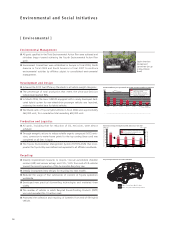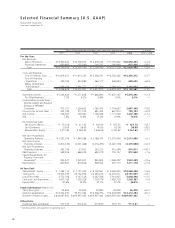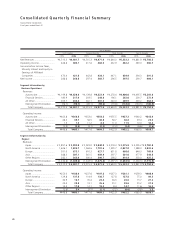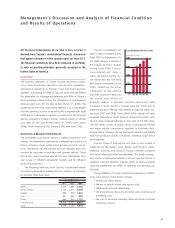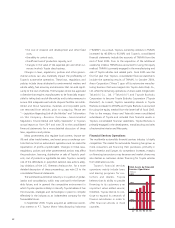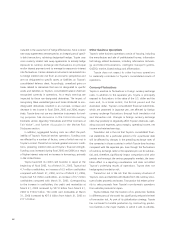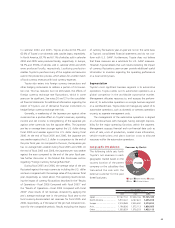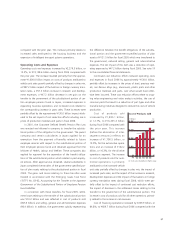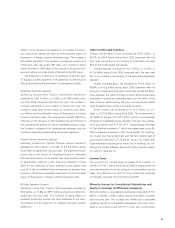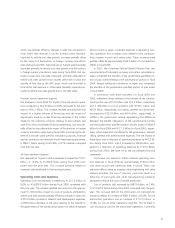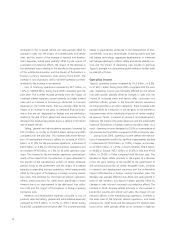Toyota 2006 Annual Report Download - page 66
Download and view the complete annual report
Please find page 66 of the 2006 Toyota annual report below. You can navigate through the pages in the report by either clicking on the pages listed below, or by using the keyword search tool below to find specific information within the annual report.64
included in the assessment of hedge effectiveness. Most interest
rate swap agreements are executed as an integral part of specif-
ic debt transactions, achieving designated hedges. Toyota uses
cross currency interest rate swap agreements to entirely hedge
exposure to currency exchange rate fluctuations on principal
and/or interest payments and to manage its exposure to interest
rate fluctuations. Certain derivative instruments are entered into
to hedge interest rate risk from an economic perspective and
are not designated to specific assets or liabilities on Toyota’s
consolidated balance sheet. Accordingly, unrealized gains or
losses related to derivatives that are not designated to specific
assets and liabilities on Toyota’s consolidated balance sheet are
recognized currently in operations. As a result, earnings are
impacted by these non-designated derivatives. The impact of
recognizing these unrealized gains and losses attributed to non-
designated derivatives resulted in an increase, increase and
decrease in net income in fiscal 2004, 2005 and 2006, respec-
tively. Toyota does not use any derivative instruments for trad-
ing purposes. See discussion in the Critical Accounting
Estimates section regarding “Derivatives and Other Contracts at
Fair Value”, and further discussion in the Market Risk
Disclosures section.
In addition, aggregated funding costs can affect the prof-
itability of Toyota’s financial services operations. Funding costs
are affected by a number of factors, some of which are not in
Toyota’s control. These factors include general economic condi-
tions, prevailing interest rates and Toyota’s financial strength.
Funding costs increased during fiscal 2005 and 2006 as a result
of higher interest rates and an increase in borrowings, primarily
in the United States.
Toyota launched its credit card business in Japan at the
beginning of fiscal 2002. As of March 31, 2005, Toyota had
4.7 million cardholders, an increase of 0.5 million cardholders
compared with March 31, 2004, and as of March 31, 2006,
Toyota had 5.4 million cardholders, an increase of 0.7 million
cardholders compared with March 31, 2005. Corresponding
to the increase in cardholders, the credit card receivables at
March 31, 2005 increased by ¥27.0 billion from March 31,
2004 to ¥144.2 billion. The credit card receivables at March
31, 2006 increased by ¥27.0 billion from March 31, 2005 to
¥171.2 billion.
Other Business Operations
Toyota’s other business operations consist of housing, including
the manufacture and sale of prefabricated homes; information
technology related businesses, including information technolo-
gy and telecommunications, intelligent transport systems,
GAZOO; marine, biotechnology and afforestation.
Toyota does not expect its other business operations
to materially contribute to Toyota’s consolidated results of
operations.
Currency Fluctuations
Toyota is sensitive to fluctuations in foreign currency exchange
rates. In addition to the Japanese yen, Toyota is principally
exposed to fluctuations in the value of the U.S. dollar and the
euro and, to a lesser extent, the British pound and the
Australian dollar. Toyota’s consolidated financial statements,
which are presented in Japanese yen, are affected by foreign
currency exchange fluctuations through both translation risk
and transaction risk. Changes in foreign currency exchange
rates may positively or negatively affect Toyota’s revenues, oper-
ating costs and expenses, gross margins, operating income, net
income and retained earnings.
Translation risk is the risk that Toyota’s consolidated finan-
cial statements for a particular period or for a particular date
will be affected by changes in the prevailing exchange rates of
the currencies in those countries in which Toyota does business
compared with the Japanese yen. Even though the fluctuations
of currency exchange rates to the Japanese yen can be substan-
tial, and, therefore, significantly impact comparisons with prior
periods and amongst the various geographic markets, the trans-
lation effect is a reporting consideration and does not reflect
Toyota’s underlying results of operations. Toyota does not
hedge against translation risk.
Transaction risk is the risk that the currency structure of
Toyota’s costs and liabilities will deviate from the currency struc-
ture of sales proceeds and assets. Transaction risk relates prima-
rily to sales proceeds from Toyota’s non-domestic operations
from vehicles produced in Japan.
Toyota believes that the location of its production facilities
in different parts of the world has significantly reduced the level
of transaction risk. As part of its globalization strategy, Toyota
has continued to localize production by constructing produc-
tion facilities in the major markets in which it sells its vehicles.


